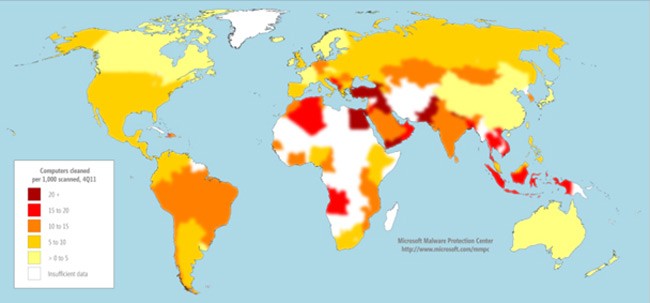Study Reveals Brazil Leads the Malware Race in Latin American Countries
Over many years, there has been countless amounts of data revealing specific regions of the world that happened to be responsible for a majority of malware during a particular time. In a recent study conducted by Kaspersky Lab, it was revealed how Brazil was the Latin American country with the highest occurrence of malware threats infected computers during the first half of 2013.
Although Brazil is the largest South American country by a long shot, it ranks among the top 100 countries in the world for malware incidents taking 35th spot. In terms of Latin American provinces, Brazil leads the way for malware incidence with Peru, Panama Honduras and Mexico still falling within the top 100 list.
Some of the startling aspects of this study is that many Latin American areas have limited Internet access, but it seems it has not put a damper on the ability for hackers in some Latin American countries to spread malware.
It is said that Brazil has had a long history of being a major player in the initiation malware throughout the world as demonstrated in Microsoft's 'Malware Infection Rates by Country/Region' heat-chart in Figure 1 below capturing the 4th quarter of the year 2011.
Figure 1 - Malware Infection Rates by Country/Region heat-map chart - Source: Microsoft

During the first half of 2013 researchers saw Panama fall just behind Brazil's 35% of the population affected by malware having just 29.4% of its citizens affected. In Peru, it reached 28.4%, while in Honduras, it was ranked at 27.7%, and Mexico was a close 27.7%.
Further braking down the figures for Latin American countries, Chile was ranked with 22.5% of its citizens affected by malware with Paraguay closely following at 22.3% and then Puerto Rico at 21.5% and Uruguay at 21.0%. These figures continue a close ranking until you seek the findings within areas that have very limited internet access, such as Cuba where only 6.3% were affected by malware in the first half of 2013.
Some of the known culprits and specific types of malware bombarding these Latin American areas were found to be banking attacks mostly through the use of advanced banking Trojans. The particular cybersecurity threats in Latin America are mostly aimed at banking institutions and banking services. One particular threat was a Trojan designed to use a Brazilian government server to collect data from victims' accounts. Just last month, many of the banking Trojans were developed to attack Linux and web browsers, such as Google Chrome, to siphon sensitive data.
Case studies such as these continually help us understand malware attacks and where authorities should be looking to crack down on cybersecurity espionage. Although Latin American countries are just one slice of the worldly malware pie, efforts in those areas can be more focused to bring perpetrators to justice.